Performance of 60 / 70 mm TP's and HFC's
#1
Former Sponsor

Thread Starter
NOTE: I've posted bits and pieces of this in various threads, but thought it would be more valuable to the forum if it were all summarized together in a single thread.
I put my car back to stock in December, so that I could take a more analytical approach to building the "perfect S2000" for myself. I tuned and dyno'ed my car (soft dyno) with each possible combination of bolt-ons that I had or could borrow to see exactly what each would do individually and in combinations. I plan to eventually post all of the results that I've collected, but what I'd like to share right now is what I discovered about the OEM catalytic converter, 60 mm test pipe, 70 mm test pipe, and 70 mm HFC.
I guess I'll start with the OEM cat. It's not surprising that there would be signficant gains from replacing the cat with a test pipe, but it seems that most people assume the benefit comes just from reducing the restriction of flow. It is true that the catalyst restricts flow some, but not as much as you might think. What became obvious early in my testing is that the stock cat actually flows VERY well. The real performance problem with the OEM cat is that it changes the "resonance" of the exhaust in such a way that VTEC engagement needs to be at a high RPM. If you lower VTEC below 5500 RPMs with the stock cat, there's a HUGE drop in power. After Hondata released their "Toda Reflash" with a 4100 RPM VTEC engagement, everyone assumed that the 6K VTEC engagement was due to the sotck header., but you'll see below that isn't the case.
Here's a soft dyno plot showing my car stock (red), stock with a 3500 RPM VTEC engagement (green), tnen stock with an "optimal" VTEC engagement at 5500 RPMs (blue). The dip in power in the green plot is NOT due to a timing or fuel tuning issue.
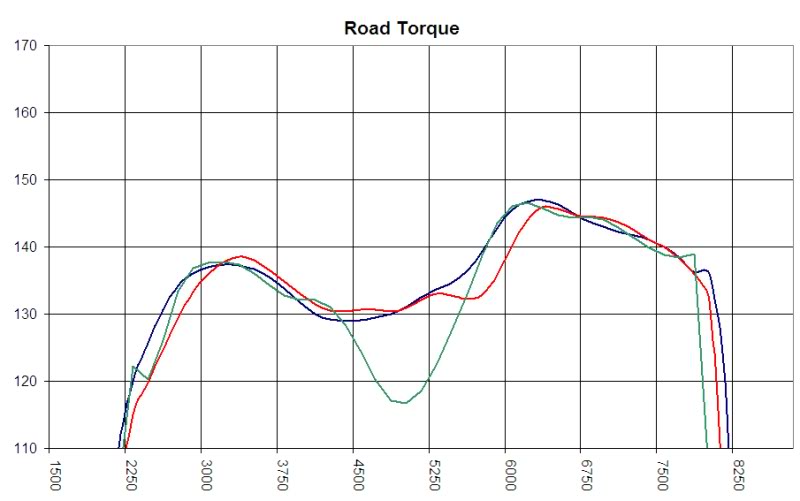
When I tested a 70mm exhaust with the stock catalytic converter, there was no measurable gain with or without a tune. This was a VERY widely disputed issue in my exhaust thread, but I believe my test was as conclusive as it can be. It seems to me that if you are going to keep the stock catalytic converter, then the ONLY reason you should consider an aftermarket exhaust is for sound, appearance, or weight savings. I don't believe there is even 1 ft-lbs of gain from any exhaust change with the stock cat.
Now on to the 60mm test pipe. I apologize if I seem inconsistent in referring to the TP as 60mm sometimes and 63mm other times. I need to check the diameter again, but the inner diameter of my test pipe is slightly larger than my stock header and slightly smaller than my stock exhaust, so I usually refer to it as "60mm". Honestly, it bothers me that exhaust parts are always measured on the outside instead of the inside. It's the inside diameter that matters, so why talk about the outer diameter?!?
Replacing the stock catalytic converter with a $60 eBay test pipe was easily the biggest bang for the buck modification ever. However, you really won't get much benefit from it unless you have a way to tune for it. This means that the test pipe and a tuning solution combined wind up being the biggest bang for the buck. If you have an '06+ AP2, then the FlashPro is a must. The addition of a test pipe to an otherwise stock S2000 gives huge gains just from loading the "Toda Reflash".
Here is a plot showing my car with the stock cat untuned (red), stock cat tuned (blue), then with the test pipe and a tune and a 3500 RPM VTEC engagement (green).
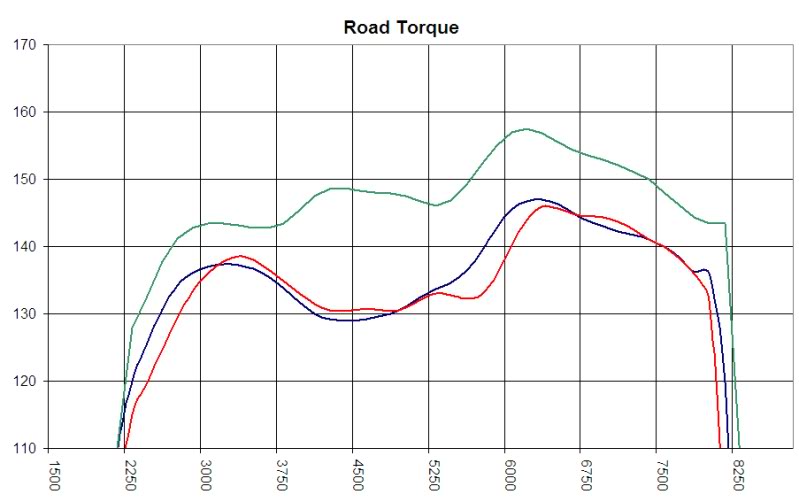
Now for the part that I was so friggin' surprised about. I've been a car enthusiast for almost 20 years, and have been on S2KI for over 8 years. I couldn't even guess how many times I've read or even written that a test pipe is a test pipe, and that the only important thing about the diameter is that it should be equal to the size of your exhaust OR header OR somewhere between them. Basically, the test pipe shouldn't be larger than your exhaust or smaller than your header. Well, that's just plain wrong!
I spent 2 weeks installing and uninstalling headers and exhausts trying to figure out why I couldn't make any gains by swapping out my OEM dual exhaust with a 70mm ASM single exhaust. There were some gains in the midrange, but nothing I would consider significant for such an expensive part. However, after enough harrassment by other people in my exhaust thread, I finally borrowed a 70mm Berk test pipe to match the 70mm ASM single. All of a sudden, there were big gains! As I mentioned earlier, my 60mm test pipe was bigger than the output of my header, so why would an extra foot of 70mm piping make a difference?!? I don't know why, but it definitely does! My guess is that it is either a resonance issue (similar to the catalytic converter) caused by having an additional "step" in diameter, or that 2 small increases in diameter causes much more turbulance than 1 large increase in diameter.
Here's a plot showing the 60mm TP with stock exhaust (blue), 60mm TP with 70mm ASM single (red), and the 70mm TP with 70mm ASM single (green). All have a 3500 RPM VTEC engagement. BTW, there were other supporting mods here, so be careful about the conclustions you might draw from comparing these plots to the plots above.
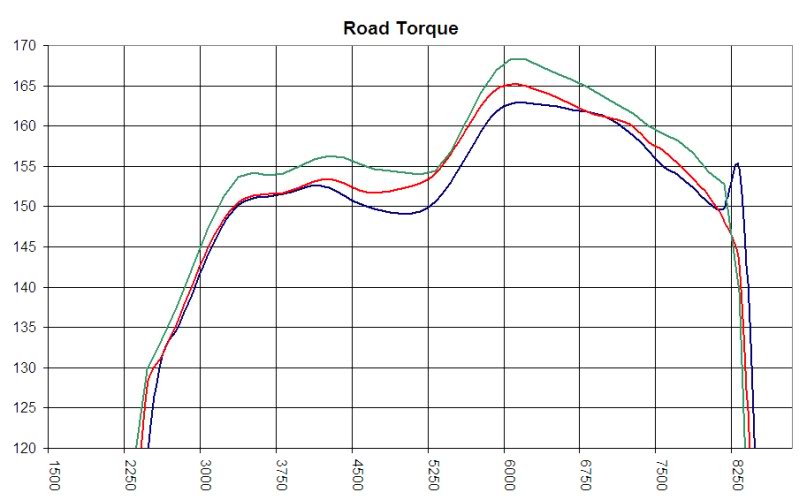
After I was finally able to show gains from the 70mm single exhaust, the topic came up in the exhaust thread about what a 70mm HFC would do. Thankfully, there was a very generous member, Vitt, who sent me a brand new Berk HFC to test with the ASM single. The results from it were very interesting.
It's clear just by looking through the Magnaflow catalyst that Berk uses that it has to be less restrictive than the OEM catalyst. However, I wasn't sure if it would have the same impact on the "resonance" of the exhaust. My hope was that it would not cause that big dip in power when VTEC engaged early. Unfortunately, it didn't eliminate that issue, but it did reduce the magnatude of the dip in power substantially.
Here is a plot showing the stock cat with 70mm ASM single (blue), 70mm HFC with the 70mm ASM single (green), and the 70mm TP with 70mm ASM single (red). All of them have VTEC engaging at 3500 RPMs to demonstrate the resonance issue on the high cam.
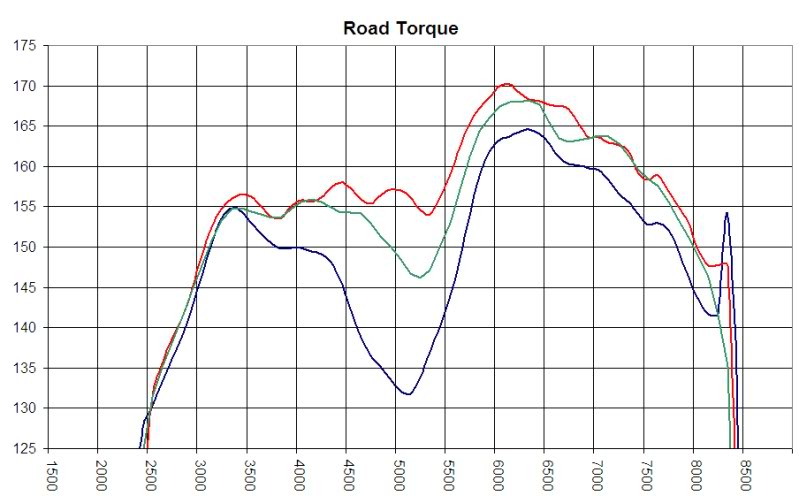
This is the AFR plot from the test above.
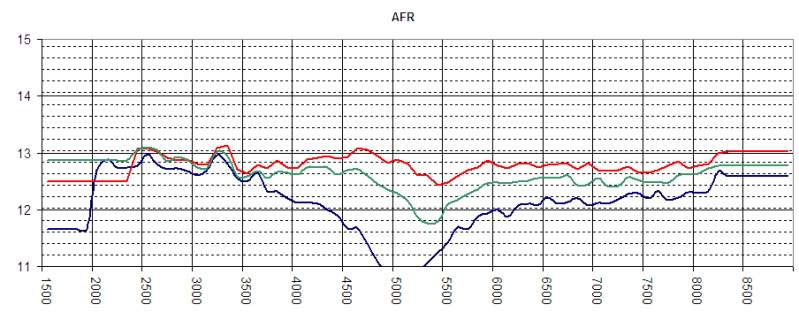
After a proper tune for the 3 combos, there's still a noticeable loss of torque at ~5K RPMs with the HFC, but it's not that bad. There was no amount of tuning that could make it beneficial to engage VTEC that low with the stock cat, so it seems that an HFC is about "half as good" as a test pipe, assuming you have the correct diameter parts.
Here is the stock cat with 70mm ASM single (red), 70mm HFC with the 70mm ASM single (blue), and the 70mm TP with 70mm ASM single (green). The HFC and TP plots both benefitted from a 3500 RPM VTEC engagement, but the OEM cat needed a 5500 RPM engagement.
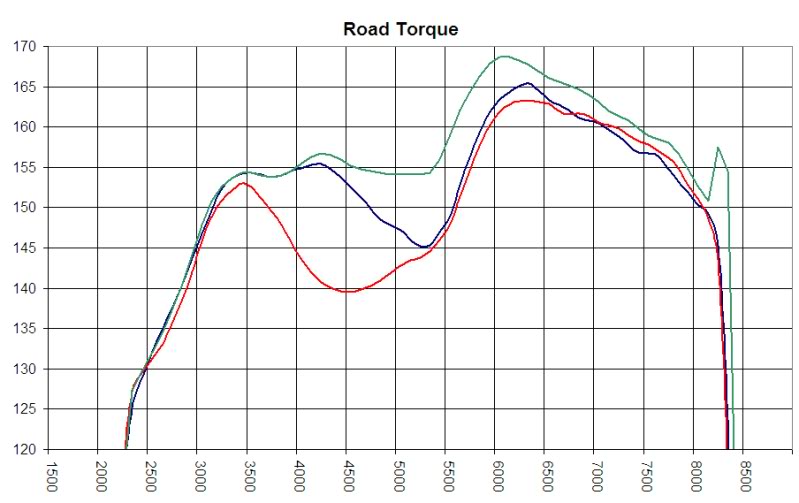
After all of this testing, I still believe that the ability to tune is the biggest MUST HAVE for performance. After that is the "correct" replacement of the stock catalytic converter. I had no idea that the selection of a test pipe or HFC was so critical to success. What I'm now wondering is how much benefit there would be from a test pipe that exactly matched the diameter of the output of the stock header, then slowly increased in diameter like a cone until reaching the exact diameter of the 70mm exhaust. I believe most people with large diameter exhausts have stock headers or aftermarket headers with 55-60mm outputs. In those cases, I think there's a need for a better connection between them!
I see that the test pipes that have to be used with the Hytech header include a transition like this depending on the size of your exhaust, but why hasn't anyone else developed a TP or HFC like this for standard fitments? It sure seems like it would be a hot seller to have a test pipe and HFC that is 63mm on the front and 70mm on the rear! Building an HFC like this would be super easy, since you'd just use the catalyst as the divider between the 2 diameters. Berk already has a 63mm and 70mm HFC available, so they would just need to make a 3rd option that's a combination of the 2...
I put my car back to stock in December, so that I could take a more analytical approach to building the "perfect S2000" for myself. I tuned and dyno'ed my car (soft dyno) with each possible combination of bolt-ons that I had or could borrow to see exactly what each would do individually and in combinations. I plan to eventually post all of the results that I've collected, but what I'd like to share right now is what I discovered about the OEM catalytic converter, 60 mm test pipe, 70 mm test pipe, and 70 mm HFC.
I guess I'll start with the OEM cat. It's not surprising that there would be signficant gains from replacing the cat with a test pipe, but it seems that most people assume the benefit comes just from reducing the restriction of flow. It is true that the catalyst restricts flow some, but not as much as you might think. What became obvious early in my testing is that the stock cat actually flows VERY well. The real performance problem with the OEM cat is that it changes the "resonance" of the exhaust in such a way that VTEC engagement needs to be at a high RPM. If you lower VTEC below 5500 RPMs with the stock cat, there's a HUGE drop in power. After Hondata released their "Toda Reflash" with a 4100 RPM VTEC engagement, everyone assumed that the 6K VTEC engagement was due to the sotck header., but you'll see below that isn't the case.

Here's a soft dyno plot showing my car stock (red), stock with a 3500 RPM VTEC engagement (green), tnen stock with an "optimal" VTEC engagement at 5500 RPMs (blue). The dip in power in the green plot is NOT due to a timing or fuel tuning issue.

When I tested a 70mm exhaust with the stock catalytic converter, there was no measurable gain with or without a tune. This was a VERY widely disputed issue in my exhaust thread, but I believe my test was as conclusive as it can be. It seems to me that if you are going to keep the stock catalytic converter, then the ONLY reason you should consider an aftermarket exhaust is for sound, appearance, or weight savings. I don't believe there is even 1 ft-lbs of gain from any exhaust change with the stock cat.
Now on to the 60mm test pipe. I apologize if I seem inconsistent in referring to the TP as 60mm sometimes and 63mm other times. I need to check the diameter again, but the inner diameter of my test pipe is slightly larger than my stock header and slightly smaller than my stock exhaust, so I usually refer to it as "60mm". Honestly, it bothers me that exhaust parts are always measured on the outside instead of the inside. It's the inside diameter that matters, so why talk about the outer diameter?!?
Replacing the stock catalytic converter with a $60 eBay test pipe was easily the biggest bang for the buck modification ever. However, you really won't get much benefit from it unless you have a way to tune for it. This means that the test pipe and a tuning solution combined wind up being the biggest bang for the buck. If you have an '06+ AP2, then the FlashPro is a must. The addition of a test pipe to an otherwise stock S2000 gives huge gains just from loading the "Toda Reflash".
Here is a plot showing my car with the stock cat untuned (red), stock cat tuned (blue), then with the test pipe and a tune and a 3500 RPM VTEC engagement (green).

Now for the part that I was so friggin' surprised about. I've been a car enthusiast for almost 20 years, and have been on S2KI for over 8 years. I couldn't even guess how many times I've read or even written that a test pipe is a test pipe, and that the only important thing about the diameter is that it should be equal to the size of your exhaust OR header OR somewhere between them. Basically, the test pipe shouldn't be larger than your exhaust or smaller than your header. Well, that's just plain wrong!
I spent 2 weeks installing and uninstalling headers and exhausts trying to figure out why I couldn't make any gains by swapping out my OEM dual exhaust with a 70mm ASM single exhaust. There were some gains in the midrange, but nothing I would consider significant for such an expensive part. However, after enough harrassment by other people in my exhaust thread, I finally borrowed a 70mm Berk test pipe to match the 70mm ASM single. All of a sudden, there were big gains! As I mentioned earlier, my 60mm test pipe was bigger than the output of my header, so why would an extra foot of 70mm piping make a difference?!? I don't know why, but it definitely does! My guess is that it is either a resonance issue (similar to the catalytic converter) caused by having an additional "step" in diameter, or that 2 small increases in diameter causes much more turbulance than 1 large increase in diameter.
Here's a plot showing the 60mm TP with stock exhaust (blue), 60mm TP with 70mm ASM single (red), and the 70mm TP with 70mm ASM single (green). All have a 3500 RPM VTEC engagement. BTW, there were other supporting mods here, so be careful about the conclustions you might draw from comparing these plots to the plots above.

After I was finally able to show gains from the 70mm single exhaust, the topic came up in the exhaust thread about what a 70mm HFC would do. Thankfully, there was a very generous member, Vitt, who sent me a brand new Berk HFC to test with the ASM single. The results from it were very interesting.
It's clear just by looking through the Magnaflow catalyst that Berk uses that it has to be less restrictive than the OEM catalyst. However, I wasn't sure if it would have the same impact on the "resonance" of the exhaust. My hope was that it would not cause that big dip in power when VTEC engaged early. Unfortunately, it didn't eliminate that issue, but it did reduce the magnatude of the dip in power substantially.
Here is a plot showing the stock cat with 70mm ASM single (blue), 70mm HFC with the 70mm ASM single (green), and the 70mm TP with 70mm ASM single (red). All of them have VTEC engaging at 3500 RPMs to demonstrate the resonance issue on the high cam.

This is the AFR plot from the test above.

After a proper tune for the 3 combos, there's still a noticeable loss of torque at ~5K RPMs with the HFC, but it's not that bad. There was no amount of tuning that could make it beneficial to engage VTEC that low with the stock cat, so it seems that an HFC is about "half as good" as a test pipe, assuming you have the correct diameter parts.
Here is the stock cat with 70mm ASM single (red), 70mm HFC with the 70mm ASM single (blue), and the 70mm TP with 70mm ASM single (green). The HFC and TP plots both benefitted from a 3500 RPM VTEC engagement, but the OEM cat needed a 5500 RPM engagement.

After all of this testing, I still believe that the ability to tune is the biggest MUST HAVE for performance. After that is the "correct" replacement of the stock catalytic converter. I had no idea that the selection of a test pipe or HFC was so critical to success. What I'm now wondering is how much benefit there would be from a test pipe that exactly matched the diameter of the output of the stock header, then slowly increased in diameter like a cone until reaching the exact diameter of the 70mm exhaust. I believe most people with large diameter exhausts have stock headers or aftermarket headers with 55-60mm outputs. In those cases, I think there's a need for a better connection between them!
I see that the test pipes that have to be used with the Hytech header include a transition like this depending on the size of your exhaust, but why hasn't anyone else developed a TP or HFC like this for standard fitments? It sure seems like it would be a hot seller to have a test pipe and HFC that is 63mm on the front and 70mm on the rear! Building an HFC like this would be super easy, since you'd just use the catalyst as the divider between the 2 diameters. Berk already has a 63mm and 70mm HFC available, so they would just need to make a 3rd option that's a combination of the 2...
The following 3 users liked this post by Gernby:
#6
Former Sponsor

Thread Starter
Originally Posted by Epic_Velocity,Jan 25 2011, 03:00 PM
Good read, so if I understood correctly, I have a 63mm T1R single, best for me would be a 60mm TP?
Trending Topics
#8
Good read.
Back when I had my AP2 I had a few different setups that seemed to yield the same/different results.
First I added a t1r 70em single exhaust to a 100% otherwise stock car. Car felt exactly the same as it did with the stock exhaust.
A couple weeks later I picked up a Berk 63mm TP. Night and Day if you ask me. Adding the TP finally made the car feel how I thought it should.
A couple months later I had the itch for nicer wheels so I sold the exhaust to help fund some Volks and slapped the stock exhaust back on but left the TP in place. Car didn't feel any slower just didn't make as much noise.
Fast forward a few more months and I decided to sell the car so I put the stock cat back on. Car felt slower again.
In my opinion the cat is by far the biggest restriction in the stock system. This was of course all on the butt dyno but I'm just reporting back what I saw.
Back when I had my AP2 I had a few different setups that seemed to yield the same/different results.
First I added a t1r 70em single exhaust to a 100% otherwise stock car. Car felt exactly the same as it did with the stock exhaust.
A couple weeks later I picked up a Berk 63mm TP. Night and Day if you ask me. Adding the TP finally made the car feel how I thought it should.
A couple months later I had the itch for nicer wheels so I sold the exhaust to help fund some Volks and slapped the stock exhaust back on but left the TP in place. Car didn't feel any slower just didn't make as much noise.
Fast forward a few more months and I decided to sell the car so I put the stock cat back on. Car felt slower again.
In my opinion the cat is by far the biggest restriction in the stock system. This was of course all on the butt dyno but I'm just reporting back what I saw.
#9
Registered User

I think if you were able to chat with Berk about their 3" exhaust, I believe they have an expansion from stock header to the 3" exhaust on both their straight pipe and HFC versions. Might have to confirm with them.
Edit: What about 70mm HFC with stock exhaust?
Edit: What about 70mm HFC with stock exhaust?







